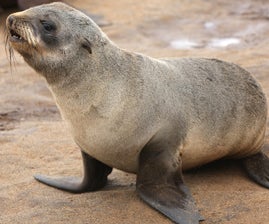-

Cape fur seals are slaughtered in Namibia. Hansjoerg Richter/istock
The seal slaughter in Namibia is one of the world’s largest remaining commercial seal hunts.
In recent years, the annual hunting quota has been set at 85,000 pups and 7,000 adult bulls. However, the Namibian authorities are notoriously secretive about the hunt and have consistently discouraged independent observation and recording, so no one really knows exactly how many seals are killed each year.
The seals are hunted for their skins, which are marketed to international fur markets, and for their organs, which are traded as aphrodisiacs.
Cape fur seal pups are killed between July and November each year when they are less than a year old. According to Namibian regulations, pups must be clubbed on the head, and then their hearts pierced with a knife to bleed them out.
During the hunt, several hundred pups may be herded together and killed within a rapid time frame (one to two hours). This usually takes place early in the morning. Ironically, later in the day tourists are often taken to the rookeries to see the seals as part of an ecotourism industry that generates far more revenue than hunting does for the local economy. The tourists are unaware that the seals they photograph may be brutally clubbed to death the next morning.
Cape fur seals
Cape fur seals (Arctocephalus pusillus pusillus), also known as South African fur seals, are members of the Otariid family of “eared seals.” The family also includes the closely related Australian fur seal and the various species of sea lion.
Cape fur seals live round the southern and southwestern coast of Africa, from Cape Cross in Nambia and around the Cape of Good Hope to Black Rocks of Cape Province in South Africa.
Adult males grow to around 2.3m in length and weigh up to 350kg; females are around half the size of the males. They spend much of their lives at sea, although they generally stay fairly close to shore, hauling out in large rookeries on rocky outcrops or sometimes on sandy beaches. Pups are born late in the year, and mating occurs soon after the pups are born.
Fluctuating population and environmental threats
The Cape fur seal has been commercially slaughtered off the coast of southern Africa since the early 17th century. By the late 1800s, twenty-three colonies had been wiped out.
Restrictions on hunting and protection measures have allowed total Cape fur seal numbers to recover to an estimated 2 million today, although numbers do fluctuate widely particularly in Namibia, where poor environmental conditions and pollution have impacted the availability of prey fish.
Although the Cape fur seal is classified as “Least Concern” on the International Union for the Conservation of Nature (IUCN) Red List of endangered species, it is listed in Appendix II of the Convention on International Trade in Endangered Species (CITES), which means that international trade in Cape fur seal products is restricted in order to protect the species from overexploitation.
South Africa banned seal hunting in 1990. Today, the Namibian slaughter is the only commercial hunt of Cape fur seals, and targets three mainland colonies in Cape Cross, Wolf Bay and Atlas Bay.
The Namibian authorities justify the hunt on the grounds that fur seals consume large amounts of commercially valuable fish species, although there is no scientific justification for this claim.
EU seal produce trade ban
The European Union prohibited trade in products of commercial seal slaughters in May 2009 and this has depressed commercial interest in seal products.
HSI believes the seal slaughter in Namibia is inherently cruel and commercially unsustainable, and is working to persuade the Namibian authorities to stop the hunt, as well as to persuade international markets to follow the EU’s example and ban the trade in the products of seal slaughter.
